|
“Russian And Jordan Dive To Find Sodom And Gomorrah”
December 14, ArchNews, UK
“Russia and Jordan have signed an agreement to search the bottom of the Dead Sea for the remains of the Biblical cities of Sodom and Gomorrah, Arabic news media reported over the weekend.
According to the report, a Russian company has agreed to conduct the search in cooperation with Jordanian authorities, picking up all costs – in exchange for exclusive rights to film a documentary of the search.
The Dead Sea
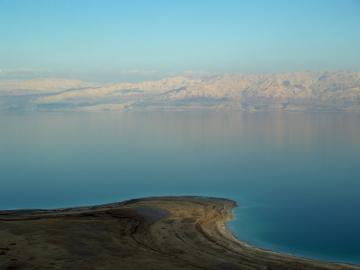
David Shankbone / ArchNews
The report quoted one of the Jordanian heads of the project, Zia Madani, as saying that the search would begin in late December.
The Russian company that was chosen as a partner for the search has special underwater exploration equipment that can stand up to the extreme salinity of the Dead Sea, the reports said.”
[Full Story]
“Over 30 ancient shipwrecks found near China coast”
December 13, Sify News, India
“Over 30 ancient shipwrecks have been discovered off China’s shoreline, the national oceanic body has said.
The shipwrecks were found during a research project called 908, the China News Service reported quoting an official with the State Oceanic Administration (SOA).
The findings were released Sunday during a seminar in Xiamen in Fujian province.
The research, conducted by the SOA between 2004 and 2009, covered 676,000 square km of inland water and territorial sea.”
[Full Story]
“Will Egypt build the first offshore underwater museum?”
November 10, Al-Ahram Wekly, Egypt
“Setting up an offshore, submarine archaeological site anywhere is not an easy task, let alone in a city with the water pollution problems of Alexandria. Yet the remarkable discoveries made by underwater archaeologists over the last decade justify further serious efforts for what would be Egypt’s first ever offshore underwater museum.
Yet the remarkable discoveries made by underwater archaeologists over the last decade justify further serious efforts for what would be Egypt’s first ever offshore underwater museum.
The site and form gives cause for conjecture. Should it be in Alexandria’s Eastern Harbour, the Sisila area, or Abu Qir Bay?
What will it look like? Should it resemble the Australian National Maritime Museum in Sydney or the Bodrum Museum of Underwater Archaeology at the spectacular Uluburun Wreck in Turkey, or the Musée de Marine in Paris? All these display a collection of sunken ship wrecks, flora and fauna.
All these display a collection of sunken ship wrecks, flora and fauna.”
[Full Story]
“Rare pistol uncovered in 18th Century shipwreck”
November 09, The St. Augustine Record, USA
“Good thing it was after hours in the Flagler Hospital Imaging Center recently when technicians ran a couple of dozen items found in an 18th century shipwreck through the center’s CAT scan.
‘We were yelling’, said Chuck Meide, archaeological director for the Lighthouse Archaeological Maritime Program. ‘It was one of those moments. A moment of discovery.’
This photo shows the encrusted pistol
as it was found on the seafloor
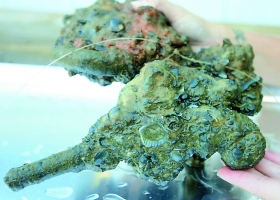
The St. Augustine Record
The discovery was a gentleman’s pocket pistol concealed in a concretion, a concrete-like mass that forms around metal artifacts as they rust in the water.
This X-ray image shows the outline of a pistol
recovered from an 18th Century shipwreck
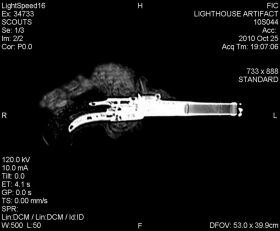
The St. Augustine Record
‘Our eyes were instantly drawn to (the pistol)’, Meide said. The pistol was one of several items that ended ‘stuck’ together.
Other artifacts included a large iron spike, lots of small lead shot known as bird shot (“really, really tiny”), an iron hook, two ring-like objects and a disk of metal.”
[Full Story]
“Sub Aquatic Archaeologists Discover Four Complete Skulls
of Extinct Animals in a Cenote”
November 07, Art Daily, USA
“Four complete skulls and jaws of a species extinct in America, Arctotherium, that lived during the Pleistocene and disappeared 11,300 years ago, were found by sub aquatic archaeologists in the bed of a cenote in the Yucatan Peninsula, Mexico.
These are the only specimens of their type found until now in this region of the country, and add up to the list of Prehistorical fauna located inside this kind of water bodies, which before glaciations were dry caves.
Sub aquatic archaeologist Guillermo de Anda Alanis, from the Yucatan Autonomous University (UADY), who conducts this research as part of the project authorized by the National Institute of Anthropology and History (INAH) ‘El Culto al Cenote en el Centro de Yucatan’ (Cult to Cenote in Central Yucatan) since 2007, announced the details of the discovery at the International Congress American Cultures and their Environment: Perspectives from Zoo Archaeology, Paleo Botanic and Ethno Biology, organized by UADY and taking place from November 1st to 5th 2010 in Merida, Yucatan.”
[Full Story]
“Scientists warn underwater cultural heritages in danger”
October 25, XinhuaNet, China
“ISTANBUL: Scientists warned here Monday that underwater cultural heritages are in danger as shipwrecks and underwater ruins are becoming increasing accessible.
The issue is the focus point of 3-day regional meeting on the protection of the underwater cultural heritage, which is host by the Istanbul Archeology Museum and organized by UNESCO.
Ulrike Guerin, Secretary of the Convention on the protection of the Underwater Cultural Heritage of UNESCO, said that the underwater cultural heritage faces danger of destruction, looting and commercial exploitation.
‘Professional equipment and a high level training remain necessary to undertake excavations since such sites are no longer beyond the reach of treasure hunters’, she said.
It is estimated that over 3 million undiscovered shipwrecks spread across ocean floors around the planet.”
[Full Story]
“A Treasure Chest Of Secrets Resurfaced”
October 17, WCTI 12 News, USA
“Archaeologists bring up more historic treasures from the bottom of the ocean, and with it–untold stories of Blackbeard.
The crew of archaeologists are diving 20 feet below the surface of our sea into Queen Anne’s Revenge.
Monday, a team pulled up a crucial part of the flagship covered in sand and sea shells. The artifact in itself can hold answers to the mysteries of Blackbeard’s life.”
[Full Story]
“Acoustic Imaging Reveals Lost Town”
October 08, 2010, Hydro International, The Netherlands:
“Off the coast of the Dunwich in Suffolk lies half a medieval town long abandoned to the sea. Despite many diver and sonar surveys, details of the site have been hidden due to poor visibility.
In June 2010, however, acoustic imaging technology was introduced to complete an archaeological survey of the site.
The site of the sunken town of Dunwich has been the subject of debate for several centuries. What remains of the ancient capital of East Anglia off the coast has been the subject of countless diving and archaeology projects.
Since the 1300s, historic buildings have been lost to the relentless encroachment of the North Sea.”
[Full Story]
“Archaeologists seeking ancient booty dive
to Blackbeard’s pirate ship”
October 05, 2010, NewsTrack India, India:
“Archaeologists are once again heading back to the sea off North Carolina’s coast in a continuing effort to recover artefacts from the wreck believed to be Blackbeard’s flagship.
The boat, called Queen Anne’s Revenge, is believed to have sunk in 1718 near Beaufort, N.C.
Archaeologists in the state aim to save a dozen cannons, which are up to 8 feet long and weigh as much as a ton, and the ship’s 1,800-pound anchors by preventing the process that corrodes iron in saltwater.”
[Full Story]
“2000-year-old pills found in Greek shipwreck”
September 10, 2010, New Scientist, UK:
“In 130 BC, a ship fashioned from the wood of walnut trees and bulging with medicines and Syrian glassware sank off the coast of Tuscany, Italy. Archaeologists found its precious load 20 years ago and now, for the first time, archaeobotanists have been able to examine and analyse pills that were prepared by the physicians of ancient Greece.
DNA analyses show that each millennia-old tablet is a mixture of more than 10 different plant extracts, from hibiscus to celery.
‘For the first time, we have physical evidence of what we have in writing from the ancient Greek physicians Dioscorides and Galen’, says Alain Touwaide of the Smithsonian Institution’s National Museum of Natural History in Washington DC.
The box of pills was discovered on the wreck in 1989, with much of the medicine still completely dry, according to Robert Fleischer of the Smithsonian’s National Zoological Park, also in Washington DC.”
[Full Story]
“Mediterranean Shipwrecks Reveal Shift
to Modern Shipbuilding”
September 07, 2010, Live Science, USA:
“Three recently discovered shipwrecks in the Mediterranean Sea could give archaeologists new insights into the transition between medieval and modern shipbuilding.
The sunken anchor from a shipwreck recently found
under the Mediterranean Sea
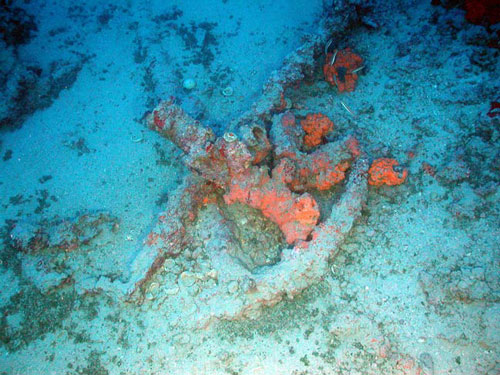
RPM Nautical Foundation
The remains of the three craft – all dating from between 1450 and 1600 – were found in the straits between Turkey and the Greek island of Rhodes.
One ship appears to be a large English merchant ship, while the other two are smaller – perhaps a patrol craft from Rhodes and a small trading boat that could have been Turkish, Italian or Greek.”
[Full Story]
“Undersea Excavation off Cyprus Confirms Mediterranean Diet”
September 07, 2010, CRI English, China:
“A recent undersea excavation by Cypriot archaeologists of a shipwreck estimated to be 2,500 years old has confirmed a large part of what is described as a Mediterranean diet, based on olive products along with wheat.
The finding has also shed more light on seafaring and commerce in the classical era.
The sunk ship, first located by amateur fishermen at a depth of 45 meters off the coast of south Cyprus, was a late classical period merchant vessel and was carrying a large quantity of wine amphorae, or clay jars.
They came mainly from the island of Chios and also from other north Aegean islands.
Photographic and drawing documentation on the wreck started in 2007 but the cargo of the ship was only recently taken off the bottom of the sea and moved to workshops of the Cyprus Archaeological Museum in the nearby city of Larnaca for conservation.”
[Full Story]
“Shipwreck ‘list’ includes local treasures”
September 05, 2010, Cape Cod Times, USA:
“Of the some 3,000 wrecks and relics in a database controlled by the Massachusetts Board of Underwater Archaeological Resources, around half are located around Cape Cod, said Victor Mastone, director and chief archaeologist for the board.
In one stretch of Nantucket Sound, where ships used to travel around the peninsula before the Cape Cod Canal was built in the early part of the 1900s, there are probably 10 underwater shipwrecks every mile, he said.
Though only 10 percent of the sites the state investigates turn out to be historically important, some deemed potentially significant — from pieces of wood washed up on the beach to canoes found in lakes — can still linger on the list ‘forever, in a sense’, Mastone said.”
[Full Story]
“Saxon boat uncovered in Norfolk’s River Ant”
September 04, 2010, BBC News, UK:
“A Saxon boat has been found during flood defence work on a Norfolk river.
Five animal skulls were found near the hollowed oak boat
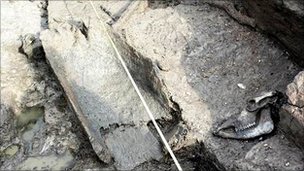
BBC News
The boat, which is about 9.8 ft long and had been hollowed out by hand from a piece of oak, was found at the bottom of the River Ant.
Five animal skulls were found near the boat, which has been taken to York for treatment to preserve it.”
[Full Story]
“It’s old… but you can drink it”
September 03, 2010, IOL, South Africa:
“Divers have salvaged what is believed to be the world’s oldest preserved beer from a 200-year-old shipwreck, the government of the semi-autonomous Aland Islands, located in the Baltic Sea between Finland and Sweden said on Friday.
‘At least three, four beer bottles were salvaged’, permanent secretary Rainer Juslin of the local government of Aland told the German Press Agency dpa.
The beer was discovered Wednesday when a bottle broke during the final salvage operation, revealing what till than had been the bottle’s unknown contents.
A team of divers earlier this summer discovered dozens of champagne bottles on the wreck in the archipelago of the Swedish- speaking islands that are part of Finland.”
[Full Story]
“Archaeologists attack BP’s drilling plans:
Damage feared to underwater sites off the coast of Libya”
September 2010 Edition, The Art Newspaper, USA:
“From Greek and Roman shipwrecks to 20th-century warships; from ancient streets with intact buildings and mosaics to amphorae and ingots, the Mediterranean is a subaqueous treasure trove.
So BP’s plans to drill exploratory oil wells off Libya has raised serious concerns among archaeologists, historians and heritage preservation organisations.
‘An oil spill off the coast of Libya would be a complete disaster’, said Claude Sintes, the director of the subaquatic team of the French archaeological mission to Libya and director of the Museum of Ancient Arles, France.
According to Sintes, there are two archaeologically rich areas along the Libyan coast Cyrenaica and Tripolitania. Within Cyrenaica lies Apollonia, an ancient harbour submerged five metres under the water.
‘It’s a complete town under the sea with streets, walls and houses. Slow tectonic movement caused it to sink’, said Sintes.”
[Full Story]
“2,000-Year-Old wrecked ship located near Hambanthota harbour in Southern Sri Lanka”
August 20, 2010, Colombo Page, Sri Lanka:
“Sri Lanka National Archaeological Department announces that an ancient ship believed to have sunk more than 2,000 years was located close to the historical Godavaya Port, close to recently opened Hambanthota harbour.
Archaeologist Sanath Karunarathne says it is believed that the newly found ship is older than 2,000 years.
Historical items including a stone bench with an ancient inscription have also been discovered among the wreckage.”
[Full Story]
“Divers surface with possibly history-changing artifacts”
August 20, 2010, WTSP 10 Connect, USA:
“In a small clearing amid the trees, divers from the University of Miami and the Florida Aquarium prepare for what could be a history-changing mission. They’re about to plunge into Little Salt Spring.
And the water here is unique; it’s an underwater archaeologist’s dream.
a UM diver holdong one of the artifacts discovered during the
Little Salt Spring underwater archaeological expedition
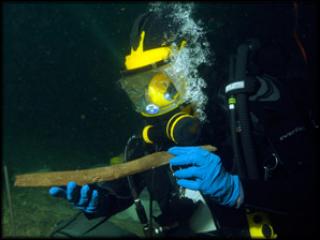
University of Miami / WTSP 10 Connect
Because the water contains no dissolved oxygen, it preserves materials like no other pre-historic site.
With some careful handling, divers delivered the possible artifacts to the surface in plastic containers.”
[Full Story]
“Archaeologists dive deep for revealing Florida artifacts”
August 19, 2010, Tampa Bay Online, USA:
“In the pitch-black depths of an isolated North Port spring sits a silt-covered ledge that is revealing secrets about a prehistoric nomadic people, secrets held in murky silence for 100 centuries.
Now, with diving gear and artifact-collecting bags, archaeologists with the University of Miami and The Florida Aquarium are sweeping away the muck and uncovering that distant past.
This stuff is from 10,000 years ago, when wandering tribes traversed Florida. Their travels included stopovers at what is now known as Little Salt Spring, 90 minutes south of Tampa.
Artifacts are delicately uncovered from a ledge 90 feet below the surface, archaeologists say, offering up glimpses of what life was like for who is believed to have been Florida’s first residents.”
[Full Story]
“Ancient Shipwrecks Found Off Central Italy’s Coast”
August 13, 2010, VOA News, Czech Republic:
“A team of marine archeologists using sonar scanners has discovered new underwater treasures in the Italian seas.
Trading vessels dating from the first century BC to the 5th through 7th centuries AD were found in the waters of the Pontine Islands. Their cargoes were found to be intact.
Newly discovered underwater treasures
in the Italian seas near the Pontine Islands
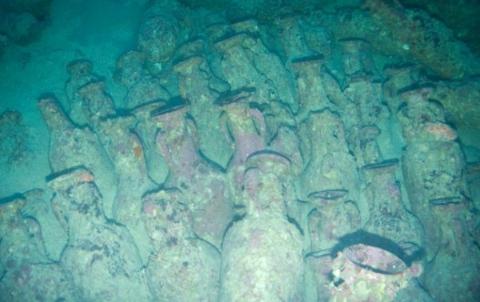
Italian Ministry of Culture / VOA News
Italian culture authorities and the Aurora Trust, a U.S. foundation which promotes underwater exploration in the Mediterranean, discovered four shipwrecks resting on the seabed.
The discovery was made in a beautiful stretch of sea off the tiny rock of Zannone, part of the Pontine Islands in central Italy.”
[Full Story]
“Atlantis of the East? No, it is a theme park”
August 04, 2010, The Daily Telegraph, UK:
“When the remains of an ancient underwater city were photographed off the coast of Bali, the Indonesian government hailed it as a potentially ‘phenomenal’ discovery.
The undersea archaeological department of the Indonesian Ministry of Culture and Tourism announced an investigation as rumours quickly circulated of 10 more such temples in the strait between Java and Bali. Excited local media speculated that an Atlantis of the East had been found.
Mystical statues of the gods, their faces covered in gorgonian fans
stood rooted to the ocean floor behind an ornate temple
gateway that is 100 feet below sea level
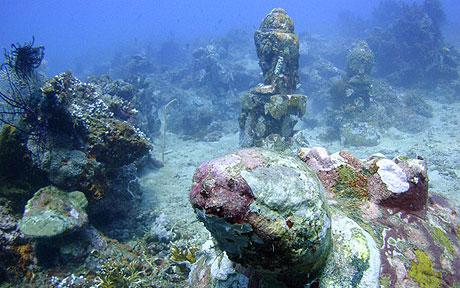
Paul Turley / The Daily Telegraph
Unfortunately, hopes of a groundbreaking discovery have been sunk. The city turns out to be an underwater theme park built by a British diver to entertain his customers
Paul Turley, 43, ‘sank’ the city in 2005 as an underwater attraction for visitors to his dive school in Pemuteran, north west Bali. He and an Australian colleague, Chris Brown, also aimed to highlight the importance of marine conservation.”
[Full Story]
“150-Year-Old Lost Ship Found in Arctic”
July 29, 2010, Discovery Channel News, USA:
“Canadian archeologists have found a ship abandoned more than 150 years ago in the quest for the fabled Northwest Passage and which was lost in the search for the doomed expedition of Sir John Franklin, the head of the team said Wednesday.
Marc-Andre Bernier, Parks Canada’s head of underwater archaeology, said the HMS Investigator, abandoned in the ice in 1853, was found in shallow water in Mercy Bay along the northern coast of Banks Island in Canada’s western Arctic.
‘The ship is standing upright in very good condition. It’s standing in about 11 meters (36 feet) of water’,he said. ‘This is definitely of the utmost importance. This is the ship that sailed the last leg of the Northwest Passage’.”
[Full Story]
“Canadians discover long-lost ship ‘fundamental’
to Arctic sovereignty”
July 28, 2010, National Post, Canada:
“The ship whose crew discovered Canada’s Northwest Passage has been found 155 years after it was abandoned and disappeared in this isolated Arctic bay, a historic find and one that may help bolster Canadian claims to Arctic sovereignty.
The wreck of HMS Investigator was detected in shallow water within days of Parks Canada archeologists launching an ambitious search for the 422-ton ship from a chilly tent encampment on the Beaufort Sea shoreline.
The wreckage of HMS Investigator was detected within days of Parks Canada launching its ambitious search for the 36-metre ship in Mercy
Bay, N.W.T.
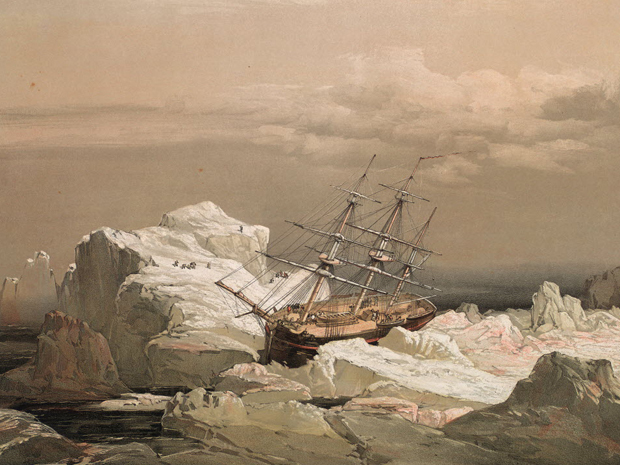
Lieut. S. Gurney Cresswell / Toronto Reference Library
‘It’s sitting upright in silt; the three masts have been removed, probably by ice’, said Ifan Thomas, Parks Canada’s superintendent of the western Arctic Field Unit. ‘It’s a largely intact ship in very cold water, so deterioration didn’t happen very quickly.’
Environment Minister Jim Prentice, who arrived at the camp on Tuesday, said that finding a relic linked to the discovery of the Northwest Passage represents a reasserted Canadian claim to Arctic sovereignty.”
[Full Story]
|